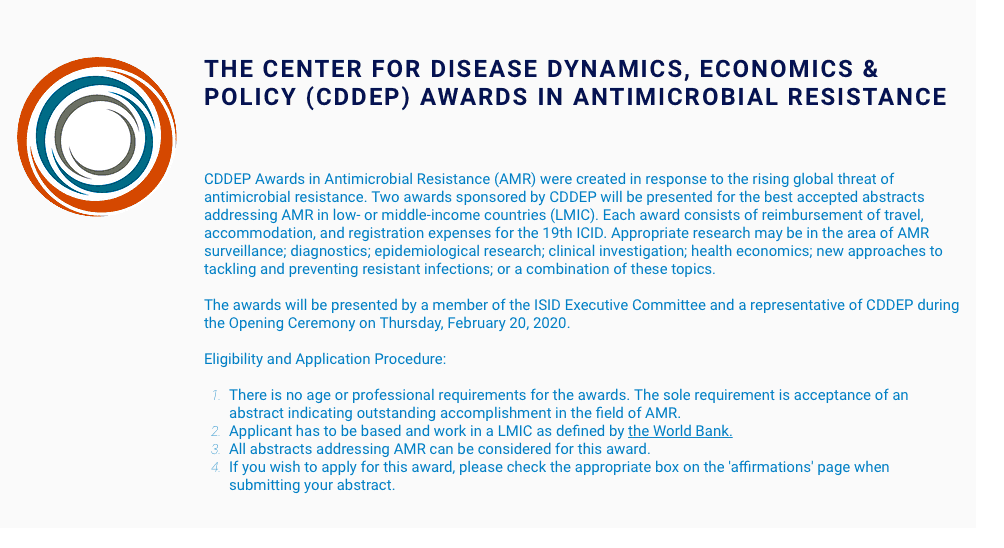June 07, 2019

Call for global R&D strategy to incentivize novel antibiotic development. An analysis conducted by researchers at CDDEP, the Norwegian Institute of Public Health, and the University of Oslo found that antibiotics approved between 1999 and 2014 fail to address urgent resistance threats. None of the 25 antibiotics brought to market in this 15-year time frame targeted resistant Gram-negative bacteria. Researchers are calling for a global research and development strategy to incentivize the development of broad-spectrum antibiotics along with alternative therapies to antibiotics. [ACS Infectious Disease]
Early childhood nutrition associated with later reproductive outcomes in Indian women. CDDEP research measured the association between supplemental childhood nutrition provided by India’s Integrated Child Development Services (ICDS) and adult reproductive outcomes among women. Using propensity score matching, researchers compared menarcheal age, age at first pregnancy, and fertility of adults across groups who received ICDS nutrition as a child versus those who did not. Results indicated that women in the ICDS nutrition group had their first menstrual period and first pregnancy 0.45 and 0.53 years later than the control group, respectively (p<0.001, p<0.05). [Maternal and Childhood Nutrition]
Outcomes of CRE bloodstream infections in LMICs. Researchers recruited 297 patients across ten low- and middle-income countries (LMICs) with either carbapenem-susceptible Enterobacteriaceae (CSE) or carbapenem-resistant Enterobacteriaceae (CRE) bloodstream infections. The study found that the crude mortality rate for patients with CSE bloodstream infections was 20 percent, compared to 35 percent among patients with CRE infections. Carbapenem resistance in LMICs was also associated with longer hospital stays (an increase of 3.7 days) and increased probability of mortality in-hospital (adjusted hazard ratio: 1.75) compared to CSE infections. [The Lancet Infectious Diseases]
Antibiotics found in two-thirds of global rivers. A global study of antibiotic levels in rivers found that 65 percent of the 711 sites tested contained antibiotics. Trimethoprim was detected at half of the sites, and ciprofloxacin levels exceeded the safety threshold at 51 sites. While rivers containing unsafe levels of antibiotics were most concentrated in Asia and Africa, sites in Europe, North America, and South America were also contaminated. Bangladesh, Kenya, Ghana, Pakistan, and Nigeria had the greatest number of sites with unsafe levels of antibiotics, with one site in Bangladesh showing antibiotic levels 300 times greater than the maximum safe level. The prevalence of antibiotics in rivers is a major concern for the spread of antimicrobial resistance, as bacteria mix and share resistant genes. [University of York]
Nipah virus reemerges in India. One man in the southern state of Kerala in India has been confirmed with Nipah virus, while 311 others are being closely monitored. Although the exposure for this case is unknown, transmission can occur through fruit-bats and pigs, and between humans. Nipah virus has a high fatality rate and last May, a Nipah outbreak that stemmed from fruit bats killed 17 people in Kerala, India. [Deccan Chronicle, Times of India, CIDRAP]
Genetically-modified fungus kills malaria-infected mosquitoes. Progress on malaria control in endemic areas has been hindered in some places by mosquitoes’ resistance to commonly used insecticides. Researchers from the University of Maryland and Institut de Recherche en Sciences de la Santé in Burkina Faso used spider venom to create a genetically-engineered toxic fungus that kills mosquitoes. In semi-field trials in Burkina Faso, black sheets coated with the modified fungus Metarhizium pingshaense were used to poison Anopheles colezzi mosquitoes. Mosquitoes in the treated group were nearly extinct after 45 days, while the control population declined slightly. While many public health researchers embrace this novel method of malaria control, some have raised concerns about possible negative effects of genetic engineering on ecosystems. [Malaria Control, NPR]
FDA allows marketing of first diagnostic test for Zika. Last month, the US Food and Drug Administration (FDA) authorized the first Zika virus diagnostic test for marketing in the US. Diagnostic tests for detecting Zika were previously only authorized for emergency use. The ZIKV Detect 2.0 IgM Capture ELISA detects Zika virus IgM antibodies in the blood, which are produced as an early immune response against Zika. [FDA]
HPV vaccine produces herd effects on prevalence rates. Using cytology specimens from cervical screenings among 20-29 year-old women in the US, in 2007, 2012-2013, and 2015-2016, researchers evaluated the impact of the human papillomavirus (HPV) vaccine on vaccine-type (VT) HPV prevalence over time. Findings showed a decreased VT prevalence among 20-24 year-olds, from 13.1 percent in 2007 to 2.9 percent in 2015-2016. Among 25-29 year-olds, VT prevalence decreased as well, from 8.1 percent to 5.0 percent during the same time period. VT prevalence decreased among both vaccinated and unvaccinated women, suggesting evidence of a herd effect. [Vaccine]
USDA report identifies high antibiotic use in US cattle. A new USDA report published findings that examined antimicrobial use on US cattle feedlots prior to 2017 FDA policy changes on the use of medically important antimicrobials in food-producing animals. The overall use of antimicrobials in feed, water, or by injection was common (87.5 percent of feedlots), with the highest use in large feedlots of over 1,000 or more head capacity. Large feedlots treated cattle as a group with injectable antimicrobials more often than small feedlots (39.3 percent compared to 12.8 percent). Some key elements of antimicrobial stewardship, such as record-keeping practices, or beef quality assurance training attendance, remained underutilized. [USDA]
The burden of C-sections in LMICs. Researchers across Europe and India conducted a systematic review and meta-analysis of 196 studies addressing the burden of cesarean sections on maternal and perinatal outcomes in low-and middle-income countries (LMICs). Among women who underwent a C-section, the overall burden of maternal death was 7.6 per 1000 procedures. Of all post-partum maternal deaths in the analysis, one-third (32.8 percent) of the women had undergone a C-section. Sub-Saharan Africa had the highest rates of maternal deaths (10.9 per 1000 procedures) and still-born babies (56.6 per 1000 procedures) following C-sections. [The Lancet]
Updated vaccination requirements for Hajj attendees. Recognizing unique health risks associated with the annual pilgrimage to Mecca, the US Centers for Disease Control and Prevention (CDC) and the Saudi Arabia Ministry of Health updated vaccine requirements and travel recommendations for pilgrims. According to the CDC’s instructions, travelers should be up to date on all routine vaccinations, including the measles-mumps-rubella vaccine. The Saudi Ministry of Health recommends that Hajj pilgrims are vaccinated against yellow fever, meningococcal meningitis, poliomyelitis, and seasonal influenza. The updated recommendations address the problem of recent and continuing outbreaks of infectious diseases around the world. Special travel vaccine counseling, including medical and financial support, has been made available to American pilgrims by the CDC. [CDC, Embassy of the Kingdom of Saudi Arabia]
Photo: Shutterstock












